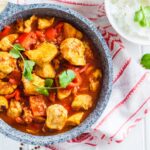South Africa is a land of culinary diversity, boasting a wide range of delectable dishes influenced by the country’s multicultural heritage. Among these culinary treasures is the renowned Durban curry, a flavorful and aromatic curry with a distinctive spicy kick. Hailing from the coastal city of Durban, this curry has captured the hearts and palates of locals and visitors alike, making it a true gastronomic delight.
Durban curry is a fusion of Indian, African, and Malaysian flavors, reflecting the diverse cultural tapestry of the region. It is said to have originated with the arrival of Indian laborers in Durban during the 19th century, who brought with them their culinary traditions and spices. Over time, this Indian-inspired curry evolved and incorporated local ingredients and cooking techniques, resulting in the unique and tantalizing Durban curry we know today.
What sets Durban curry apart is its fiery heat and complex blend of spices. The curry paste, known as masala, is the heart and soul of this dish. It typically includes a combination of ground spices such as coriander, cumin, turmeric, fenugreek, cardamom, and cloves, among others. The masala is often made from scratch, with each family or cook having their secret blend of spices, resulting in a curry paste that is distinct and flavorful.
The heat in Durban curry comes from the generous use of chili peppers, particularly the fiery bird’s eye chili or the local variety known as “Durban poison.” These chilies add a powerful kick to the dish, making it a delight for spice lovers. However, the spiciness can be adjusted according to personal preference, allowing for a milder or hotter version of the curry.
In addition to the spice blend, Durban curry features a variety of ingredients that contribute to its complex flavors. Proteins such as chicken, beef, lamb, or seafood are commonly used, while vegetarian options like lentils or vegetables are also popular. The curry is typically cooked with onions, tomatoes, garlic, and ginger, which provide a rich base and add depth to the dish. Coconut milk or cream is often incorporated to create a creamy and luscious texture that balances the heat of the spices.
Durban curry is traditionally served with fragrant basmati rice, which helps to temper the spiciness and absorb the flavors of the curry. It is also accompanied by a variety of condiments, such as chutneys, pickles, and sambals, which provide additional layers of taste and texture. A popular condiment is the famous “Mrs. Balls Chutney,” a sweet and tangy fruit chutney that perfectly complements the robust flavors of the curry.
This beloved dish holds a special place in South African culinary culture. Durban curry is not only enjoyed at home but also prominently featured in local eateries, known as “bunny chow shops.” Bunny chow, another iconic Durban creation, is a unique street food where the curry is served in a hollowed-out loaf of bread, creating a portable and satisfying meal.
The popularity of Durban curry has transcended South African borders, gaining recognition on the international culinary stage. Food enthusiasts from around the world seek out authentic Durban curry experiences, whether by visiting South African restaurants or trying their hand at recreating the flavors in their own kitchens.
In conclusion, the spicy kick of South African Durban curry is a flavorsome delight that showcases the country’s culinary heritage and multicultural influences. Its fiery heat, aromatic spices, and complex flavors make it a truly memorable dish that tantalizes the taste buds. Whether enjoyed in a bustling Durban eatery or savored at home, Durban curry is a testament to the rich tapestry of South African cuisine and a true delight for spice lovers.








